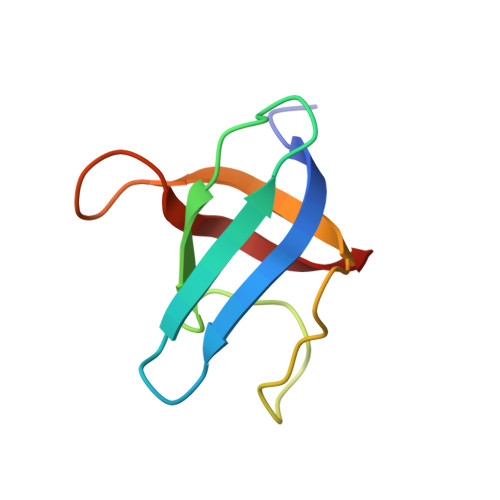Solution NMR structure and backbone dynamics of the major cold-shock protein (CspA) from Escherichia coli: evidence for conformational dynamics in the single-stranded RNA-binding site.
Feng, W., Tejero, R., Zimmerman, D.E., Inouye, M., Montelione, G.T.(1998) Biochemistry 37: 10881-10896
- PubMed: 9692981
- DOI: https://doi.org/10.1021/bi980269j
- Primary Citation of Related Structures:
3MEF - PubMed Abstract:
The major cold-shock protein (CspA) from Escherichia coli is a single-stranded nucleic acid-binding protein that is produced in response to cold stress. We have previously reported its overall chain fold as determined by NMR spectroscopy [Newkirk, K., Feng, W., Jiang, W., Tejero, R., Emerson, S. D., Inouye, M., and Montelione, G. T. (1994) Proc. Natl. Acad. Sci. U.S.A. 91, 5114-5118]. Here we describe the complete analysis of 1H, 13C, and 15N resonance assignments for CspA, together with a refined solution NMR structure based on 699 conformational constraints and an analysis of backbone dynamics based on 15N relaxation rate measurements. An extensive set of triple-resonance NMR experiments for obtaining the backbone and side chain resonance assignments were carried out on uniformly 13C- and 15N-enriched CspA. Using a subset of these triple-resonance experiments, the computer program AUTOASSIGN provided automatic analysis of sequence-specific backbone N, Calpha, C', HN, Halpha, and side chain Cbeta resonance assignments. The remaining 1H, 13C, and 15N resonance assignments for CspA were then obtained by manual analysis of additional NMR spectra. Dihedral angle constraints and stereospecific methylene Hbeta resonance assignments were determined using a new conformational grid search program, HYPER, and used together with longer-range constraints as input for three-dimensional structure calculations. The resulting solution NMR structure of CspA is a well-defined five-stranded beta-barrel with surface-exposed aromatic groups that form a single-stranded nucleic acid-binding site. Backbone dynamics of CspA have also been characterized by 15N T1, T2, and heteronuclear 15N-1H NOE measurements and analyzed using the extended Lipari-Szabo formalism. These dynamic measurements indicate a molecular rotational correlation time taum of 4.88 +/- 0.04 ns and provide evidence for fast time scale (taue < 500 ps) dynamics in surface loops and motions on the microsecond to millisecond time scale within the proposed nucleic acid-binding epitope.
Organizational Affiliation:
Center for Advanced Biotechnology and Medicine, Department of Molecular Biology and Biochemistry, Rutgers University, Piscataway, New Jersey 08854-5638, USA.














